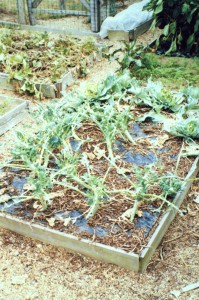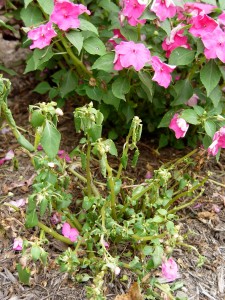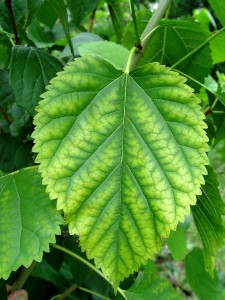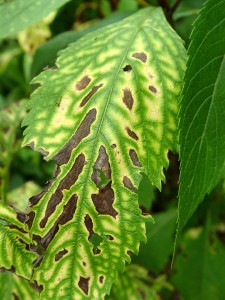What’s Wrong With My Plant?
January 13th, 2012
The most amazing part about gardening is that sometimes plants actually live.
When you think about all the things that can – and often do – go wrong, it’s a wonder anything makes it for very long.
We’ve got oven-like July afternoons that can melt a plant almost as fast as a minus-22-degree winter can freeze them.
Bugs munch on leaves.
Rabbits, deer and groundhogs chew plants to the ground while voles finish off the roots.
Various diseases can denude trees and shrubs, cause tumor-like growths on limbs or clog up plant vessels faster than a sumo wrestler on a doughnut-only diet.
And do you know the difference between damage from monsoon and drought (which we sometimes get in the same week)? A monsoon causes a fast, root-rotting plant death while a drought causes a slow, root-shriveling death.
The tough part for home gardeners is figuring out what’s causing – or about to cause – a plant’s demise.
That’s not even easy for professionals because unlike people, plants can’t point to where it hurts. Nor can they tell you when the problem started or what was going on around them at the time.
“It’s a lot like playing detective,” says Lisa Blum, a plant pathologist who taught horticulture for 18 years at Temple University before taking a teaching job at W.B. Saul High School, Philadelphia’s esteemed school for agricultural sciences.
Blum likes to call diagnosing plant problems “Plant CSI” because it’s so similar to the popular forensics Crime Scene Investigation TV show (except without the commercial breaks and dramatic confessions).
Unless you catch a groundhog waddling away with your cabbage between his teeth, all you’re usually going to have are sometimes-obscure signs and symptoms, she says.
Signs are direct clues – things you can see that are likely causing the trouble. That would include things like pepper-sized leaf fungi viewed under a hand lens; little brown “pellets” (rabbit poop) next to the chewed-off petunias, or as once happened to me, a gaping, fender-high gash in an oak trunk where a drunken teen-ager had driven his car down my sidewalk the night before.
“I love it when people seal a problem in a plastic bag WITH the insect or fungi that caused it,” Blum says.
Symptoms are tougher. These are how plants have reacted to a problem. The best we can do with them is deduce what might have caused the reaction.
That’s particularly hard because the same symptom can be caused by a lot of different things.
Take wilting, for example.
That can happen because it hasn’t rained for three weeks, and the roots have no water to take in. But it also can happen because you or Mother Nature has overdone water to the point of rotting out the roots. Dead roots in soggy soil can’t move water up to the leaves either, so the leaves display the same wilting.
Then again, leaves might wilt from animals chewing the roots, or from Verticillium fungi clogging the vessels, or from intense heat, or from over-fertilizing, or from pot-bound plants in solid clay, or… you get the picture.
Sometimes patterns of trouble on a plant can give you important clues.
Diseases, for instance, often work their way up a tree or shrub from the bottom, while problems on just one side can indicate things like sun or wind damage or possibly herbicide spray drift.
So what CAN you do besides throw up your hands and pray for God to cut you a botanical break?
For starters, know what plants you have.
“Usually, we identify a problem by comparing what’s normal with what’s abnormal,” Blum says. “So first, you have to know what normal is.”
A good example is the beautiful baby Korean stewartia tree I planted in my back yard a few years ago. Its bark has started peeling off, which seems ominous unless you know that’s what it normally does.
Ditto if you plant a larch or a dawn redwood that starts dropping its needles in fall. These are “evergreens” that aren’t evergreens… They’re conifers that lose their needles every year like maples lose their leaves.
Or if you’re buying a winterberry holly, be aware that only the females get berries – and only then when a male with an overlapping bloom time pollinates her.
Next, pay attention to your landscape. Take regular walks to enjoy the plants, and while you’re gawking and sniffing, watch for early signs and symptoms that something’s amiss.
You may, for instance, notice leaves turning pale green between dark veins, a likely sign of overly alkaline soil or lack of iron. Or you may see the tiny white flecks of a developing adelgid or scale infestation.
Even if you have no idea what could be causing a problem, at least if you know the plant and know something’s not normal, you’ve got a shot at figuring it out.
Penn State Extension’s cadre of Master Gardeners is an excellent source of help. Most counties have them, and some, like Cumberland and Dauphin, have regular hours when they man phones or clinics.
Most garden centers also have staffers who can help ID a problem if you take a clipping or bagged bug in.
And these days, the Internet offers a growing number of sites with photos, question guides and free tip sheets to help zero in on exact problems and their treatments. (See below for some online and other help sources.)
I should point out that one of the worst things you can do is just start spraying something in hopes that it’ll magically cure the problem.
Maybe you’ll guess right. But then again, you might kill off the “good bugs” that are helping keep a lid on all sorts of other potential problems. Or you might make a problem worse or at the least, waste your time and money while needlessly polluting.
The smarter approach is to: A.) Make sure you’ve really got a problem; B.) Figure out what that problem is; C.) Determine if it’s a serious enough problem that you need to intervene, and D.) Choose the least disruptive treatment to get the job done.
That might not make great TV, but it makes boringly good sense.
Some things that go wrong with plants and what may cause it:
* Plant is yellowing all over: Poor soil fertility; extreme heat; light is too intense or lacking; plant is pot bound.
* Young leaves are yellow: Not enough light; iron or manganese deficiency in the soil; excessive fertilizer.
* Old leaves are yellow: Nitrogen, magnesium or potassium deficiency in the soil; overwatering; natural aging of leaves; plant is pot bound; roots are rotting.
* Random leaves or needles yellowing or browning:Mite damage; herbicide spray drift; root or stem injury; stem galls.
* Dead or yellow spots on leaves: Fungal, bacterial or viral infection; excessive fluoride in the soil; pesticide damage.
* Holes in leaves: Caterpillar, slug or other bug damage; fungal leaf spot disease; hail or wind damage.
* Mosaic pattern of light and dark green on leaves: Viral infection; excessive heat; pesticide damage; nutrient deficiency in the soil.
* Leaves brown around the edges: Wind damage; excessive salt in the soil; lack of water; excessive fertilizer; pesticide damage; air pollution.
* Leaves falling off: Excessive fertilizer; lack of water; reaction to move or transplanting; cold damage; pesticide damage; lack of light; rotting roots; natural life cycle of plant.
* Leaves wilted: Under- or over-watering; excessive fertilizer; roots or stems rotting; rodent damage to roots; pesticide damage; frost damage; excessive heat.
* Weak growth and/or gradual dieback of branches: Lack of water; root injury or girdling roots; compacted soil; plant was planted too deeply; excessive mulch; poor soil nutrition; lack of light.
Source: Penn State Extension, Dr. Gary Moorman
A few resources to help you track down plant problems:
* “Woody Ornamental Insect, Mite and Disease Management.” An 86-page guide from Penn State Extension that describes dozens of the most common plant bugs and diseases plant by plant and suggests treatments. $15. Order at this web site.
* A rundown with sketches on most of what can go wrong with plants and how to zero in on what it might be in your case: http://pubs.ext.vt.edu/426/426-714/426-714.html
* University of Maryland’s Landscape Problem Solver. A free and superb online plant diagnostic web site that walks you through a series of choices (all with pictures) to help you zero in on likely causes. It’s at http://plantdiagnostics.umd.edu.
* Penn State University’s Plant Disease Diagnostic Laboratory. Based at Buckhout Lab in University Park, this service accepts samples of hurting plants, examines them and sends a report on the findings. Details are at http://plantpath.psu.edu/facilities/plant-disease-clinic
* Check out the book “What’s Wrong With My Plant?” by Dan Deardorff and Kathryn Wadsworth (Timber Press, 2009). It’s loaded with great images to help you match up your problems, and it tells you how to address the problem without poisoning yourself or the environment.











